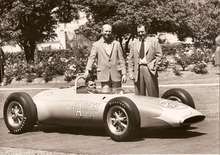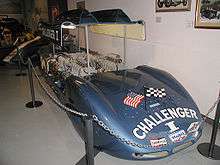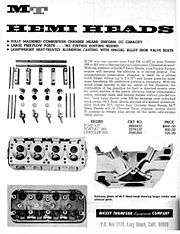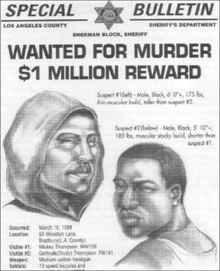Mickey Thompson
Marion Lee "Mickey" Thompson (December 7, 1928 – March 16, 1988) was an American auto racing builder and promoter.
Mickey Thompson | |
|---|---|
 The 1962 Harvey Aluminium Special Indianapolis 500 car with Thompson in the car, a Harvey representative standing on left and John Crosthwaite on the right | |
| Born | Marion Lee Thompson December 7, 1928 Alhambra, California, United States |
| Died | March 16, 1988 (aged 59) Bradbury, California, United States |
| Cause of death | Murder |
| Occupation | Race car driver |
| Known for | First American to break the 400 mph barrier |
| Spouse(s) | Judy Thompson Trudy Thompson |
| Children | Danny Thompson |
A hot rodder since his youth, Thompson increasingly pursued land speed records in his late 20s and early 30s.[1] He achieved international fame in 1960, when he became the first American to break the 400-mph barrier, driving his Challenger 1 to a one-way top speed of 406.60 mph at the Bonneville Salt Flats and surpassing John Cobb's one-way world record mark of 402 mph.
Thompson then turned to racing, winning many track and dragster championships. In the 1960s, he also entered cars at the Indianapolis 500. Later, he formed off-road racing sanctioning bodies SCORE International and Mickey Thompson Entertainment Group (MTEG).
In 1988, Thompson and his wife Trudy were mysteriously gunned down at their home in Bradbury, California. The crime remained unsolved until 2007, when a former business partner was convicted of having orchestrated the murders.[2]
Early history

Thompson was born in Alhambra, California. In his early 20s, he worked as a pressman[1] for the Los Angeles Times while pursuing a lifelong love of hot rodding. He later became involved in the new sport of drag racing. Tireless and innovative, he found success as a championship driver and instinctive automotive technician.
Over the course of his career, Thompson set more speed and endurance records than any other man in automotive history. He is credited with designing and building the first slingshot dragster, in 1954, moving the seat behind the rear axle to improve traction when existing racing tires proved unable to handle the output of increasingly powerful custom engines.[3] This car, the Panorama City Special, debuted at the first NHRA U.S. Nationals at the Great Bend Municipal Airport in Great Bend, Kansas, in 1955.[4] The car ultimately ran a best speed of 151.26 mph (243.43 km/h).[5] A change so momentous would not happen again until Don Garlits introduced the rear-engined digger in 1971.[6] Thompson also was noted for being the first manager of Lions Drag Strip in Wilmington, California, in 1955.
Thompson collaborated with Fritz Voight on a 1958 twin-engined dragster.[7] This car achieved a best speed of 294.117 mph (473.335 km/h).[5] It provided lessons later applied to Challenger I.[5] Determined to set a new land speed record,[1] Thompson achieved fame when he drove his four-engined Challenger 1 at better than 400 mph (640 km/h) in 1960 at the Bonneville Salt Flats,[8] becoming the first American to break that barrier.
Indy years
1962
In 1962, Thompson entered three John Crosthwaite-designed cars in the Indianapolis 500. Unusually, they used a stock V8 Buick engine, and it was in the rear unlike the front-engined, race-tuned, Offenhauser-powered cars used by most competitors. It was the first stock engine to be raced at Indy since 1946. Thompson's crew, led by Fritz Voigt, was young, smart, and hard working. Working 12- to 14-hour days, the car was designed and built in 120 days. For the race, the engine (enlarged to 4.2-L capacity, the maximum allowed by the regulations for "stock block" engines) had to be detuned because they were concerned it would not last the distance. Despite being more than 70 bhp down on the other cars, Dan Gurney qualified eighth and was in ninth place until a leaking oil seal seized the gearbox and ended his race on lap 94. He was placed 20th out of 33. The team won the Mechanical Achievement Award for original design, construction, and accomplishment.[9][10]
1963
Thompson's promotional skills pleased the sponsors with the publicity generated that year. For the 1963 Indianapolis 500, Crosthwaite designed the innovative Harvey Aluminium Special "roller skate car" with the then-pioneering 12 in (300 mm) diameter wheels with smaller-profile racing tires, 7 in (180 mm) wide at the front and 9 in (230 mm) rear. Thompson took five cars to Indianapolis - two of the previous year's design with Chevrolet V8 engines and three roller skate cars. One of the new cars, the Harvey Titanium Special, featured a lightweight titanium chassis. Al Miller raced one of the modified 1962 cars to ninth place despite only qualifying in 31st position. Duane Carter qualified one of the roller skate cars 15th, but was only placed 23rd after an engine failure on the 100th lap. The small tire sizes and low car weights caused complaints among the old hands and owners, so for future races, cars were restricted to minimum tire sizes and minimum car weights.[11][12]
1962 Formula One World Champion Graham Hill tested one of the roller skate cars at Indianapolis in 1963, but refused to race it, citing its poor handling. The recent ruling required 15-in wheels, but the chassis was designed around smaller wheels. Thompson commented: "The car wouldn't handle", adding, "There was too much body roll due to the high center of gravity."[13]
In 1963, Thompson traveled to England, where along with Dante Duce, he demonstrated his Ford-powered top fuel Harvey Aluminum Special dragster at the Brighton Speed Trials. It was then displayed at the Racing Car Show in London in January 1964.[14]
1964
Thompson brought three modified 12-inch-tired cars to the 1964 Indianapolis 500, but new rules required him to use 15-in tires. The Allstate sponsored team used Allstate tires and Ford engines. The chassis had to be altered to accommodate the larger Ford engines. Two of them qualified for the race. The car No. 84 began the month with Masten Gregory as the driver, but Eddie Johnson in car No. 84 qualified 24th and finished 26th. Dave MacDonald in car No. 83 qualified 14th and died in a fiery crash on the second lap.
1965–1968
Thompson went back to Indy in 1965, but failed to qualify in an attempt with a front-engined roadster. He skipped 1966, but tried again in 1967 and 1968, again failing to qualify either year.[15] The 1967 attempt used a unique all-wheel drive rear-engined design that steered both front and rear wheels, but Gary Congdon was unable to qualify any of the three cars.[16][17]
Post Indy

In 1965, Thompson published Challenger: Mickey Thompson's own story of his life of Speed. In 1968 Danny Ongais and him took three Ford Mustang Mach 1 to the Bonneville salt flats for a feature in Hot Rod magazine, in the process setting 295 speed and endurance records over a series of 500-mile and 24-hour courses.[18][19] Together with John Buttera and Pat Foster, developed a Ford Mustang Mach 1] Funny Car with a dragster-like chassis. Driven by Ongais, the car won the 1969 NHRA Spring Nationals at Dallas and the NHRA U.S. Nationals.[20]
In his long career, Thompson raced vehicles from stock cars to off-road, and engineered numerous competition engines. He went into the performance aftermarket business in the early 1960s and then, in 1963, he created "Mickey Thompson Performance Tires" that developed special tires for racing including for Indianapolis 500 competitors.
Thompson founded SCORE International in 1973, a sanctioning body to oversee off-road racing across North America. His wife Trudy and he formed the Mickey Thompson Entertainment Group (MTEG), which ran an indoor motocross and off-road vehicle racing show and competition that brought the sport from the back-country to major metropolitan stadiums and arenas.

Murder

On March 16, 1988, Thompson and his wife Trudy were killed by two hooded gunmen outside their home in Bradbury, California, in the foothills of the San Gabriel Mountains.[2]
On the morning of the murder, a pair of unknown assailants waited outside the Thompson home for the couple to leave for the day. Mickey opened the garage door for his wife to pull out in her vehicle, and as he headed for his own car, the gunmen attacked. He was shot and wounded, then dragged out into the driveway while one of the attackers went after Trudy as she backed out. Killing her, the gunman then came back up the driveway, where the other gunman was watching over Mickey and shot him fatally in the head.[2] The attackers then made their escape on the bicycles they had ridden to the Thompson residence. Expensive jewelry and a large amount of cash were found on the Thompsons' bodies, eliminating robbery as a likely motive.
An intense police investigation initially failed to uncover either the identity of the mystery gunmen, or a motive for the crime. Police were interested in Thompson's former business partner Michael Frank Goodwin who repeatedly refused to pay a more than $768,000 settlement he owed Thompson. Goodwin and his wife bought $275,000 worth of gold coins two months before the Thompsons were murdered and wired $400,000 to banks on the island Grand Turk and Caicos. Goodwin and his wife then left the country five months after the murder on their yacht and did not return for more than two years.[21]
The case remained unsolved until 2001, when Goodwin was charged in Orange County, California with the murders.[2] Before a trial could be completed, it was ended on jurisdictional grounds by the California District Court of Appeal. On June 8, 2004, Goodwin was formally charged with the murders in Pasadena, in Los Angeles County. In October 2006, a Pasadena Superior Court judge ordered Goodwin to stand trial.[2]
During the trial, a long series of witnesses reported hearing Goodwin threaten to kill the Thompsons. “I’m going to kill that son of a bitch. I’m going to kill that motherfucker. I’m going to take out Mickey. I’m too smart to get caught. I’ll have him wasted. He’ll never see a nickel. I’ll kill him first. Mickey doesn’t know who he is fucking with. He is fucking dead.”[21]
Although the prosecution did not establish a direct connection between the murderers and Goodwin, the circumstancial evidence was sufficient to convict him. On January 4, 2007, a jury found Goodwin guilty of two counts of murder in the death of Thompson and his wife. Goodwin was sentenced to two consecutive life-without-parole terms. A subsequent motion for a new trial was denied.[2] In the 2015 California 2nd District Court of Appeal ruling, although no direct evidence connected Goodwin to the case, the array of circumstantial evidence was found to be "overwhelming".[22] The two men who murdered the Thompsons have not been located.
TV coverage, and its fictionalization through the television program CSI, were cited by the defense team during the murder trial as having created a "folklore" around the case, preventing a fair trial.[23]
Thompson, his wife, and his pets are interred in the Rose Hills Memorial Park, in Whittier, California.
In popular culture
- CBS's To Tell The Truth. Appeared as a contestant in March of 1962[24]
- NBC's Unsolved Mysteries
- Investigation Discovery's Murder Book.
- CBS television program 48 Hours Mystery April 28, 2007
- CSI episode "Early Rollout" (2004) was based on this murder case.
Awards
- Thompson was inducted posthumously to the Motorsports Hall of Fame of America[25] and the International Motorsports Hall of Fame in 1990.
- Thompson was ranked No. 11 on the National Hot Rod Association Top 50 Drivers, 1951–2000
- Thompson was inducted posthumously to the Off-Road Motorsports Hall of Fame in 2007, and the Automotive Hall of Fame in 2009.
See also
- Stadium Super Trucks, a racing series inspired by Thompson's stadium off-road racing
- Danny Thompson, Thompson's son, also a race car driver
References
- "The Hottest Hot Rodder in the World." Popular Science, December 1959, pp. 95-98/218.
- "Guilty verdict in Thompson murder case - latimes". Articles.latimes.com. 2007-01-05. Retrieved 2016-08-27.
- Hot Rod, 12/86, p.29 sidebar.
- Taylor, Thom. "Mickey Thompson Panorama City Special", in "Beauty Beyond the Twilight Zone", p.31.
- Taylor, p.31.
- Hot Rod, 12/86, p.28.
- Taylor, Thom. "Mickey Thompson, Fritz Voight dragster", in "Beauty Beyond the Twilight Zone", p.31.
- "Gassing up with Mickey Thompson and the Challenger I streamliner | Hemmings Daily". Blog.hemmings.com. Retrieved 2016-08-27.
- Car and Driver August 1962
- Motor Trend June 1962, MotorSport June 1962, Motor August 1962, Mickey Thompson Archived 2010-11-30 at the Wayback Machine, Indianapolis 500 Mile Race USAC Yearbook 1962. Floyd Clymer, San Diego Union newspaper May 27th 1962, San Diego Union newspaper June 1st 1962, Los Angeles Times newspaper May 17th 1962, Los Angeles Times newspaper June 1st 1962, Road & Track magazine June 1962
- Hot Rod magazine May 1963
- Road & Track magazine June 1963, Motor Trend magazine June 1963, Car & Driver magazine June 1963, Car and Driver magazine August 1963, Bang Shift : Gallery : Mickey Thompson exhibit at the NHRA museum Archived 2011-05-19 at the Wayback Machine, Mickey Thompson - Indy 500 1963 Archived 2012-02-14 at the Wayback Machine, Indianapolis 500 Mile Race USAC Yearbook 1963, Floyd Clymer
- Thomas, Bob (Dec 6, 1963). "Thompson in All-Out Indy Bid, Hires MacDonald as New Driver". Los Angeles Times.
- See: The Observer, January 26, 1964, Page 19.
- Garner, Art, "Black Noon: The Year They Stopped the INDY 500", Page 316, Thomas Dunne Books, 2014.
- "Archived copy". Archived from the original on 2015-03-15. Retrieved 2014-08-03.CS1 maint: archived copy as title (link)
- "1967 Indianapolis 500". Racing-Reference.info. 1967-05-30. Retrieved 2016-08-27.
- "Danny Thompson Returns to the Salt in an E85-Fueled Mach 1 Mustangs". Hot Rod. 16 February 2009.
- 1969 Ford Mustang Mach I - Record Setter - Hot Rod, 9 July 2014
- The Mystery of the Blue Mustang - Phil Burgess, NHRA, 22 April 2016
- Murder On the Last Turn LA Weekly October 18, 2006
- Hamilton, Matt (Jan 26, 2015). "Conviction upheld in 1988 killing of racing legend Mickey Thompson". Los Angeles Times. Retrieved 16 June 2018.
- "Goodwin Found Guilty In Mickey Thompson Murder Trial". NBC4 TV. January 4, 2007. Archived from the original on 2007-01-05.
- https://www.youtube.com/watch?v=s6P2IHOtQSU&feature=youtu.be&t=1137
- Mickey Thompson at the Motorsports Hall of Fame of America
Sources
- Taylor, Thom. "Beauty Beyond the Twilight Zone" in Hot Rod, April 2017, pp. 30–43.
External links
- News release on documentary of the murder (dead link)
- Trial Commentary
- M/T Tires Official Page
- Michael Goodwin profile on America's Most Wanted
- Murder On the Last Turn LA Weekly October 18, 2006